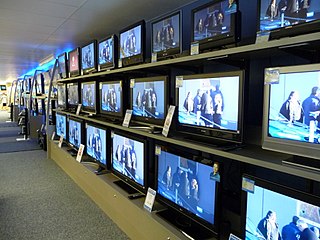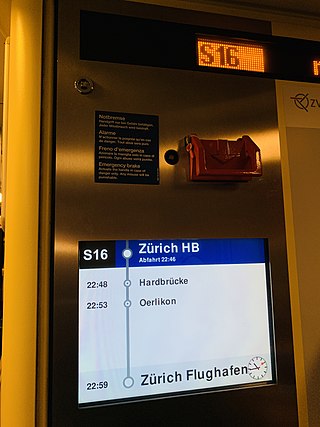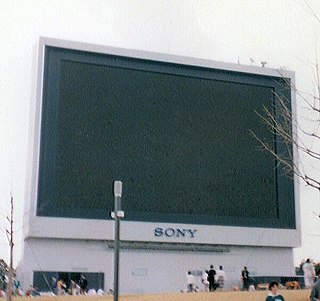
Television (TV) is a telecommunication medium for transmitting moving images and sound. Additionally, the term can refer to a physical television set rather than the medium of transmission. Television is a mass medium for advertising, entertainment, news, and sports. The medium is capable of more than "radio broadcasting," which refers to an audio signal sent to radio receivers.

Electroluminescence (EL) is an optical and electrical phenomenon, in which a material emits light in response to the passage of an electric current or to a strong electric field. This is distinct from black body light emission resulting from heat (incandescence), chemical reactions (chemiluminescence), reactions in a liquid (electrochemiluminescence), sound (sonoluminescence), or other mechanical action (mechanoluminescence), or organic electroluminescence.

A flat-panel display (FPD) is an electronic display used to display visual content such as text or images. It is present in consumer, medical, transportation, and industrial equipment.

In the signage industry, neon signs are electric signs lighted by long luminous gas-discharge tubes that contain rarefied neon or other gases. They are the most common use for neon lighting, which was first demonstrated in a modern form in December 1910 by Georges Claude at the Paris Motor Show. While they are used worldwide, neon signs were popular in the United States from about the 1920s to 1950s. The installations in Times Square, many originally designed by Douglas Leigh, were famed, and there were nearly 2,000 small shops producing neon signs by 1940. In addition to signage, neon lighting is used frequently by artists and architects, and in plasma display panels and televisions. The signage industry has declined in the past several decades, and cities are now concerned with preserving and restoring their antique neon signs.

A display device is an output device for presentation of information in visual or tactile form. When the input information that is supplied has an electrical signal the display is called an electronic display.

A jumbotron, sometimes referred to as jumbovision, is a video display using large-screen television technology. The original technology was developed in the early 1980s by Mitsubishi Electric and Sony, which coined JumboTron as a brand name in 1985. Mitsubishi Electric sold their version of the technology as Diamond Vision. It is typically used in sports stadiums and concert venues to show close up shots of an event or even other sporting events occurring simultaneously, as well as outdoor public places.
Out-of-home (OOH) advertising, also called outdoor advertising, outdoor media, and out-of-home media, is advertising experienced outside of the home. This includes billboards, wallscapes, and posters seen while "on the go". It also includes place-based media seen in places such as convenience stores, medical centers, salons, and other brick-and-mortar venues. OOH advertising formats fall into four main categories: billboards, street furniture, transit, and alternative.

Neon lighting consists of brightly glowing, electrified glass tubes or bulbs that contain rarefied neon or other gases. Neon lights are a type of cold cathode gas-discharge light. A neon tube is a sealed glass tube with a metal electrode at each end, filled with one of a number of gases at low pressure. A high potential of several thousand volts applied to the electrodes ionizes the gas in the tube, causing it to emit colored light. The color of the light depends on the gas in the tube. Neon lights were named for neon, a noble gas which gives off a popular orange light, but other gases and chemicals called phosphors are used to produce other colors, such as hydrogen (purple-red), helium, carbon dioxide (white), and mercury (blue). Neon tubes can be fabricated in curving artistic shapes, to form letters or pictures. They are mainly used to make dramatic, multicolored glowing signage for advertising, called neon signs, which were popular from the 1920s to 1960s and again in the 1980s.
Pattison Outdoor Advertising is a Canadian out-of-home advertising company owned by the Jim Pattison Group. According to the Canadian Out-of-Home Measurement Bureau, it was Canada's largest out-of-home advertising company in 2013, holding more than 55% of the national market share in horizontal posters and a 43% market share of all traditional out-of-home media.

Digital signage is a segment of electronic signage. Digital displays use technologies such as LCD, LED, OLED, projection and e-paper to display digital images, video, web pages, weather data, restaurant menus, or text. They can be found in public spaces, transportation systems, museums, stadiums, retail stores, hotels, restaurants and corporate buildings etc., to provide wayfinding, exhibitions, marketing and outdoor advertising. They are used as a network of electronic displays that are centrally managed and individually addressable for the display of text, animated or video messages for advertising, information, entertainment and merchandising to targeted audiences.

Clear Channel Outdoor Americas, Inc. (CCOA) is an out-of-home (OOH) advertising company based in San Antonio, Texas with operations throughout the U.S. and the Caribbean. CCOA is one of two separate business units operating as part of Clear Channel Outdoor Holdings, Inc. (CCOH). The other business unit, Clear Channel International (CCI), includes Europe, Singapore and Latin America. Globally, both CCOA and CCI employ 5,800 people.

Signage is the design or use of signs and symbols to communicate a message. Signage also means signs collectively or being considered as a group. The term signage is documented to have been popularized in 1975 to 1980.

A video wall is a special multi-monitor setup that consists of multiple computer monitors, video projectors, or television sets tiled together contiguously or overlapped in order to form one large screen. Typical display technologies include LCD panels, Direct View LED arrays, blended projection screens, Laser Phosphor Displays, and rear projection cubes. Jumbotron technology was also previously used. Diamond Vision was historically similar to Jumbotron in that they both used cathode-ray tube (CRT) technology, but with slight differences between the two. Early Diamond vision displays used separate flood gun CRTs, one per subpixel. Later Diamond vision displays and all Jumbotrons used field-replaceable modules containing several flood gun CRTs each, one per subpixel, that had common connections shared across all CRTs in a module; the module was connected through a single weather-sealed connector.

A destination sign or destination indicator/destination blind is a sign mounted on the front, side or rear of a public transport vehicle, such as a bus, tram/streetcar or light rail vehicle, that displays the vehicle's route number and destination, or the route's number and name on transit systems using route names. The main such sign, mounted on the front of the vehicle, usually located above the windshield, is often called the headsign, most likely from the fact that these signs are located on the front, or head, end of the vehicle. Depending on the type of the sign, it might also display intermediate points on the current route, or a road that comprises a significant amount of the route, especially if the route is particularly long and its final terminus by itself is not very helpful in determining where the vehicle is going.
An electronic visual display is a display device that can display images, video, or text that is transmitted electronically. Electronic visual displays include television sets, computer monitors, and digital signage. They are ubiquitous in mobile computing applications like tablet computers, smartphones, and information appliances. Many electronic visual displays are informally referred to as screens.
Electrically operated display devices have developed from electromechanical systems for display of text, up to all-electronic devices capable of full-motion 3D color graphic displays. Electromagnetic devices, using a solenoid coil to control a visible flag or flap, were the earliest type, and were used for text displays such as stock market prices and arrival/departure display times. The cathode ray tube was the workhorse of text and video display technology for several decades until being displaced by plasma, liquid crystal (LCD), and solid-state devices such as thin-film transistors (TFTs), LEDs and OLEDs. With the advent of metal–oxide–semiconductor field-effect transistors (MOSFETs), integrated circuit (IC) chips, microprocessors, and microelectronic devices, many more individual picture elements ("pixels") could be incorporated into one display device, allowing graphic displays and video.
A text display is an electronic alphanumeric display device that is mainly or only capable of showing text, or extremely limited graphic characters. This includes electromechanical split-flap displays, vane displays, and flip-disc displays; all-electronic liquid-crystal displays, incandescent eggcrate displays, LED displays, and vacuum fluorescent displays; and even electric nixie tubes.
An emergency communication system (ECS) is any system that is organized for the primary purpose of supporting one-way and two-way communication of emergency information between both individuals and groups of individuals. These systems are commonly designed to convey information over multiple types of devices, from signal lights to text messaging to live, streaming video, forming a unified communication system intended to optimize communications during emergencies. Contrary to emergency notification systems, which generally deliver emergency information in one direction, emergency communication systems are typically capable of both initiating and receiving information between multiple parties. These systems are often made up of both input devices, sensors, and output/communication devices. Therefore, the origination of information can occur from a variety of sources and locations, from which the system will disseminate that information to one or more target audiences.

Screen-Smart Device Interaction (SSI) is fairly new technology developed as a sub-branch of Digital Signage.
City of Austin v. Reagan National Advertising of Austin, LLC, 596 U.S. ___ (2022), was a United States Supreme Court case dealing with the application of zoning restrictions on digital billboards in the city of Austin, Texas. In a 6–3 ruling, the Court ruled that the Austin regulation against off-premise digital signs was content-neutral and thus should be reviewed as a facial challenge rather than a strict scrutiny following from the reasoning in Reed v. Town of Gilbert.
















